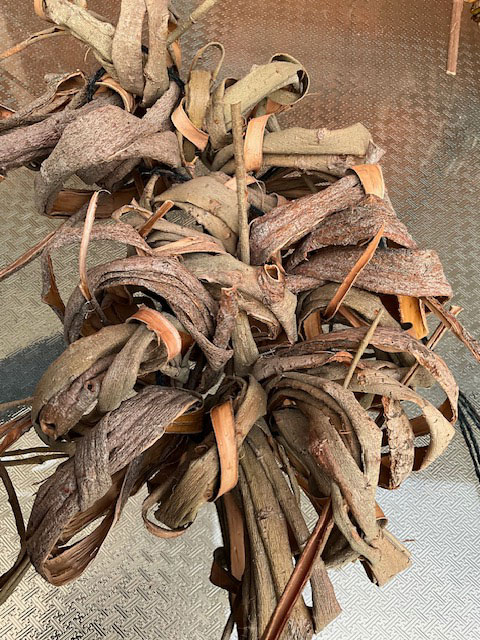
Willow Bark
Sandi McNeil has often read that willow bark was suitable for basket weaving, but she could never find any willow that was large enough to peel. That changed last spring when she discovered a clump of willow growing by her pond. Sh knew it was willow as they were growing jumbo pussy willows!
Sandi waited until the end of July to cut the willow trees down. She cut the branches off until she had a small trunk about 5 feet long. Using an awl, she lifted the bark off the thick end of the trunk and started to pull upward. The bark peeled easily with only a few knot holes and no stickiness. It was similar in colour to cedar, but had a different texture. It was thinner than was expected so she did not try to separate the inner and outer bark.
She cut the bark into long strips of weavers and coiled them up to dry. As they dried, she noticed the edges were curling. This indicates shrinkage is going on. There is no way to tell what bark is going to have a shrinkage factor. The shrinkage however, does not prevent the bark from being used, and it gives Sandi another option for colour and texture in her repertoire of natural materials.

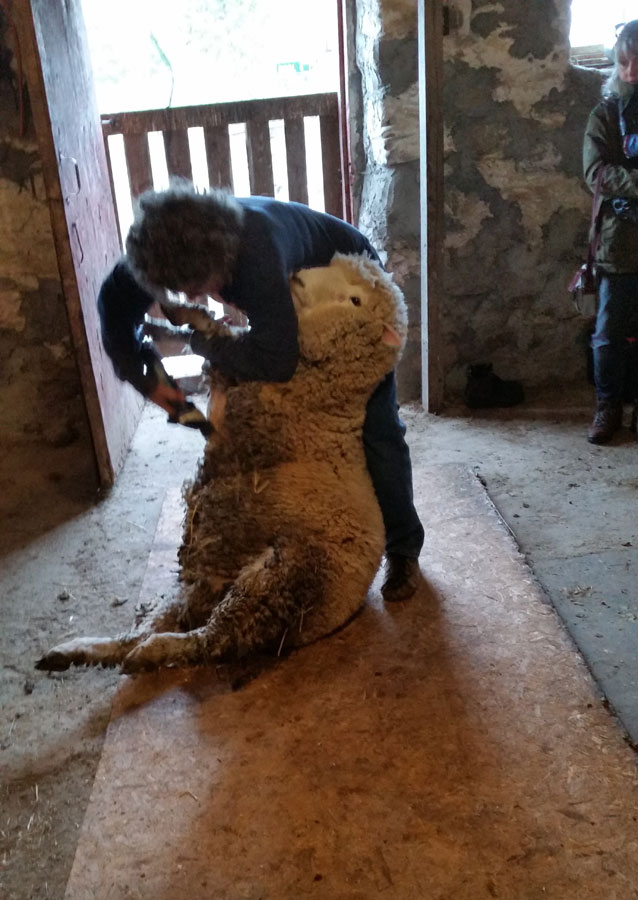
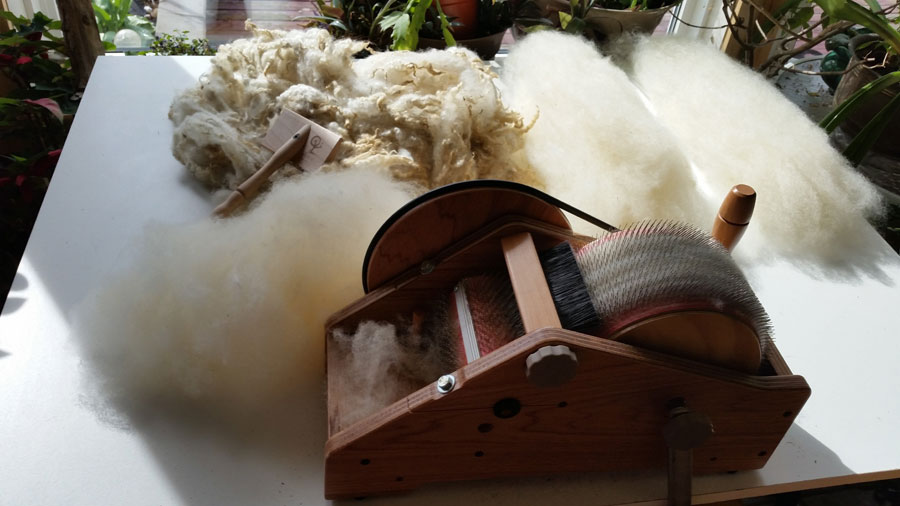
 “You’ve got too many irons in the fire!” Mom’s words still reverberate in my head each time a new creative idea wanders in. How can I choose on which to spend my energy and resources. These ideas seem to flood in and fight for attention in those “tiny grey cells” as Hercule Poirot would say. So many ideas, so little time. The beauty of nature from micro to macro cause visions of intricate texture and explosions of colours to overwhelm my mind. Then I must try to confine these ideas to only a few selected mediums.
“You’ve got too many irons in the fire!” Mom’s words still reverberate in my head each time a new creative idea wanders in. How can I choose on which to spend my energy and resources. These ideas seem to flood in and fight for attention in those “tiny grey cells” as Hercule Poirot would say. So many ideas, so little time. The beauty of nature from micro to macro cause visions of intricate texture and explosions of colours to overwhelm my mind. Then I must try to confine these ideas to only a few selected mediums.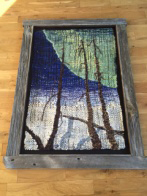 In mid December I learned of an artist who put out a call to weavers from around the world. American conceptual artist Helen Mirra was organizing an exhibit titled “Standard Incomparable”. Weavers were to submit two identical pieces with specific parameters. Each piece was to be an arms breadth wide and an arms breadth long. Each piece was to be divided into seven equal stripes. The stripes could be differentiated by either colour or pattern. The pieces were to be minimally finished with a rolled hem. The yarns used had to be locally obtained and undyed. Did I mention my entire family was coming home for two weeks at Christmas? I had to find these yarns. The pieces were to be at the Isabella Stewart Gardner Museum in Boston by February 27. I had researched patterns and had several potentials selected, ones that would showcase the yarns. By mid-January I had found two local yarn sources, beautiful wool and mohair blends, one light in colour and one dark.
In mid December I learned of an artist who put out a call to weavers from around the world. American conceptual artist Helen Mirra was organizing an exhibit titled “Standard Incomparable”. Weavers were to submit two identical pieces with specific parameters. Each piece was to be an arms breadth wide and an arms breadth long. Each piece was to be divided into seven equal stripes. The stripes could be differentiated by either colour or pattern. The pieces were to be minimally finished with a rolled hem. The yarns used had to be locally obtained and undyed. Did I mention my entire family was coming home for two weeks at Christmas? I had to find these yarns. The pieces were to be at the Isabella Stewart Gardner Museum in Boston by February 27. I had researched patterns and had several potentials selected, ones that would showcase the yarns. By mid-January I had found two local yarn sources, beautiful wool and mohair blends, one light in colour and one dark.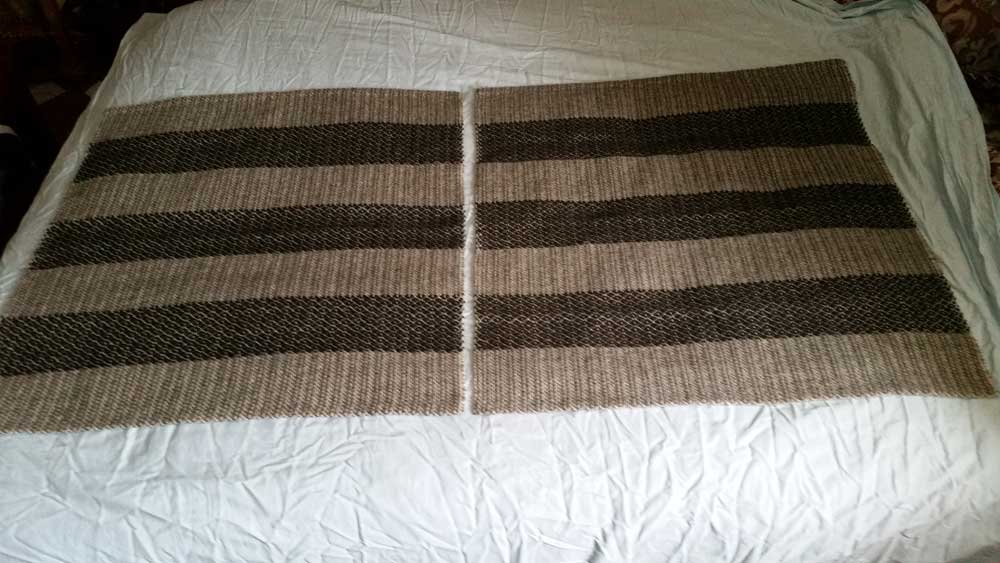 I started over, right from the beginning using a different technique. I’m glad I did. The second warp was remarkably better. I was amazed as I weighed and measured each piece, they were exactly the same size and weight to the tenth of an ounce. I packaged and mailed the pieces to Boston.
I started over, right from the beginning using a different technique. I’m glad I did. The second warp was remarkably better. I was amazed as I weighed and measured each piece, they were exactly the same size and weight to the tenth of an ounce. I packaged and mailed the pieces to Boston.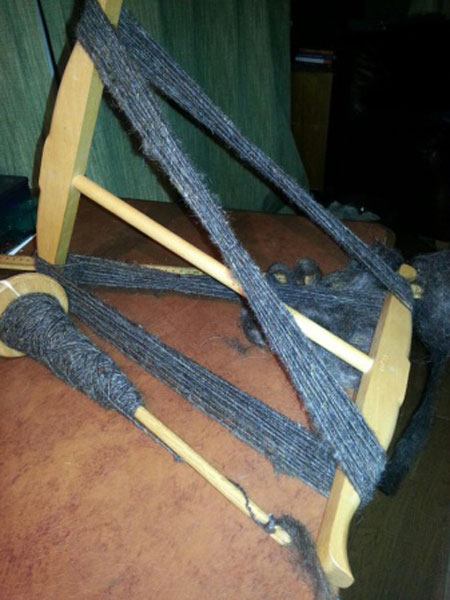 To improve my spinning techniques I have been practicing on my spinning wheel and spinning using drop spindles that were turned and carved by my Dad. I have sought out advice from the spinners in the
To improve my spinning techniques I have been practicing on my spinning wheel and spinning using drop spindles that were turned and carved by my Dad. I have sought out advice from the spinners in the 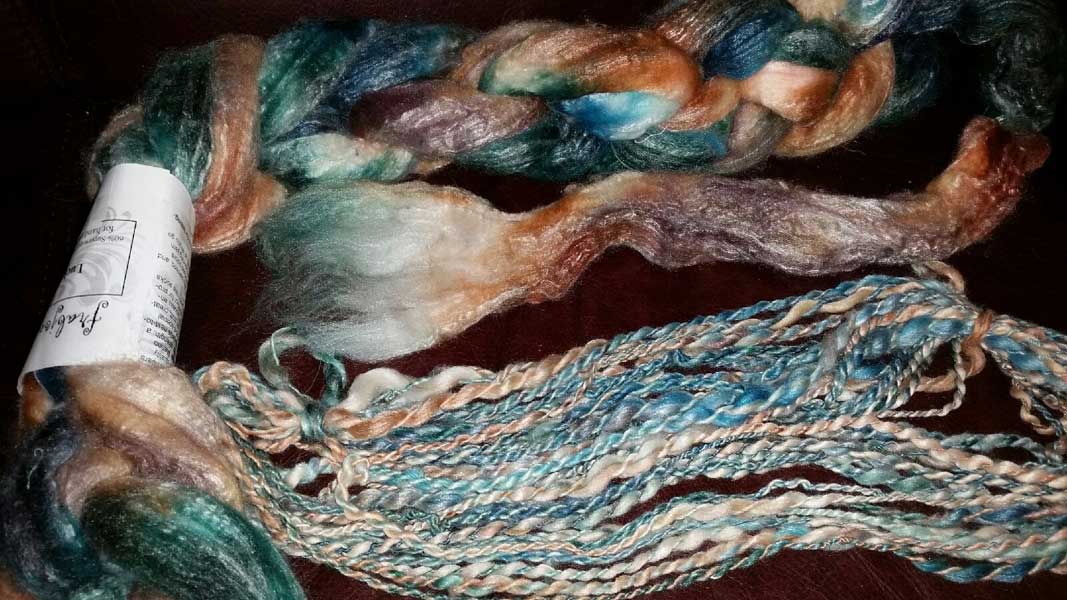
 In the process of gathering cedar bark I cut down the entire tree. However I use different parts of the tree for different purposes, and nothing is wasted. After cutting down the cedar tree, I cut all the limbs off, leaving a short stub on the trunk so the bark will lift off more easily. The peeled trunk is put aside and is used for landscaping, bridge building and kindling wood. The cedar bark that I peel off, is processed into weavers, and is one of my favourite materials to use for basket weaving. Large branches and small diameter trunks form the legs for twig furniture. Smaller branches are put to one side and are also used in twig furniture. This year however, I found a new use for the small cedar branches that I haven’t thought of before! I love it when I get a new idea that I am pretty certain will work out successfully. I don’t know why I haven’t thought of this idea before!!
In the process of gathering cedar bark I cut down the entire tree. However I use different parts of the tree for different purposes, and nothing is wasted. After cutting down the cedar tree, I cut all the limbs off, leaving a short stub on the trunk so the bark will lift off more easily. The peeled trunk is put aside and is used for landscaping, bridge building and kindling wood. The cedar bark that I peel off, is processed into weavers, and is one of my favourite materials to use for basket weaving. Large branches and small diameter trunks form the legs for twig furniture. Smaller branches are put to one side and are also used in twig furniture. This year however, I found a new use for the small cedar branches that I haven’t thought of before! I love it when I get a new idea that I am pretty certain will work out successfully. I don’t know why I haven’t thought of this idea before!!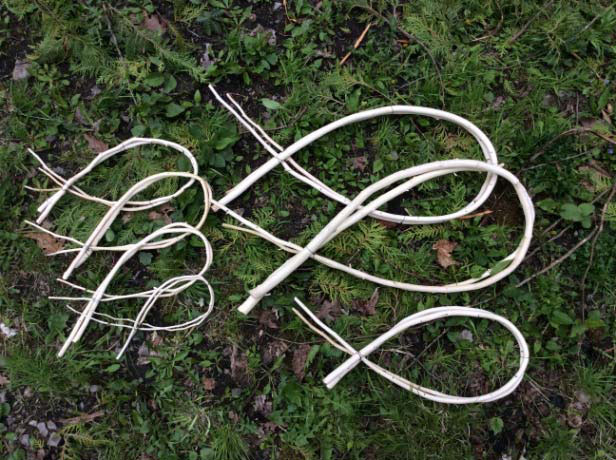 In the past, I have often peeled vines and used them for basket frames. I have peeled basswood branches for wall weavings. I almost always include peeled willow and peeled dogwood in my baskets, but I have never peeled cedar branches with the intent of making a basket frame. Impulsively, I decided to peel a pair of small cedar branches, exposing the creamy coloured wood that I knew was underneath. Then I carefully bent and flexed the cedar branch over my knee so it would bend to form a fish basket shape without breaking. This worked well because the branches were so fresh, so I made several fish basket shapes and wired each pair together. I have set these frames aside in my studio to let them dry out. If I keep them out of the weather they should slowly age to a yellowish patina.
In the past, I have often peeled vines and used them for basket frames. I have peeled basswood branches for wall weavings. I almost always include peeled willow and peeled dogwood in my baskets, but I have never peeled cedar branches with the intent of making a basket frame. Impulsively, I decided to peel a pair of small cedar branches, exposing the creamy coloured wood that I knew was underneath. Then I carefully bent and flexed the cedar branch over my knee so it would bend to form a fish basket shape without breaking. This worked well because the branches were so fresh, so I made several fish basket shapes and wired each pair together. I have set these frames aside in my studio to let them dry out. If I keep them out of the weather they should slowly age to a yellowish patina.

